- Second-Round Pick Taelon Peter Brings Shooting, Athleticism NBA
- Kam Jones Selected 38th Overall In NBA Draft Marquette University Athletics
- Flame drafted to Indiana Pacers Liberty University
- NBA legend Dwyane Wade delivers powerful shout-out to Kam Jones after No. 38 NBA draft pick by Indiana Pa Times of India
- Former Coaches Give Insight On The Newest Pacers 93.5 / 107.5 The Fan
Author: admin
-
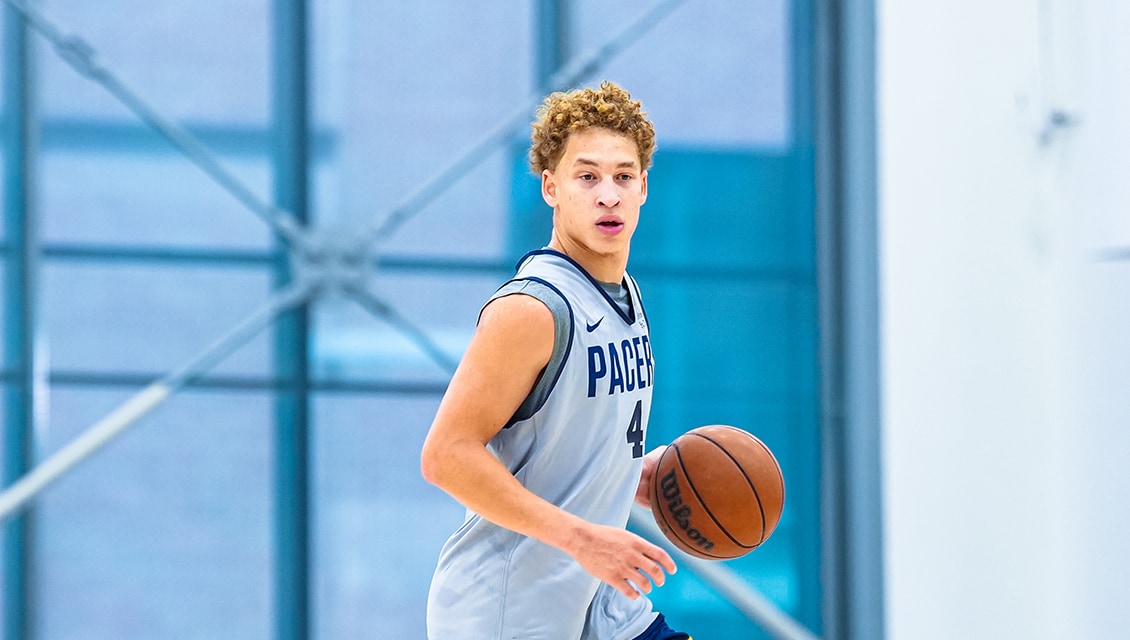
Second-Round Pick Taelon Peter Brings Shooting, Athleticism – NBA
-
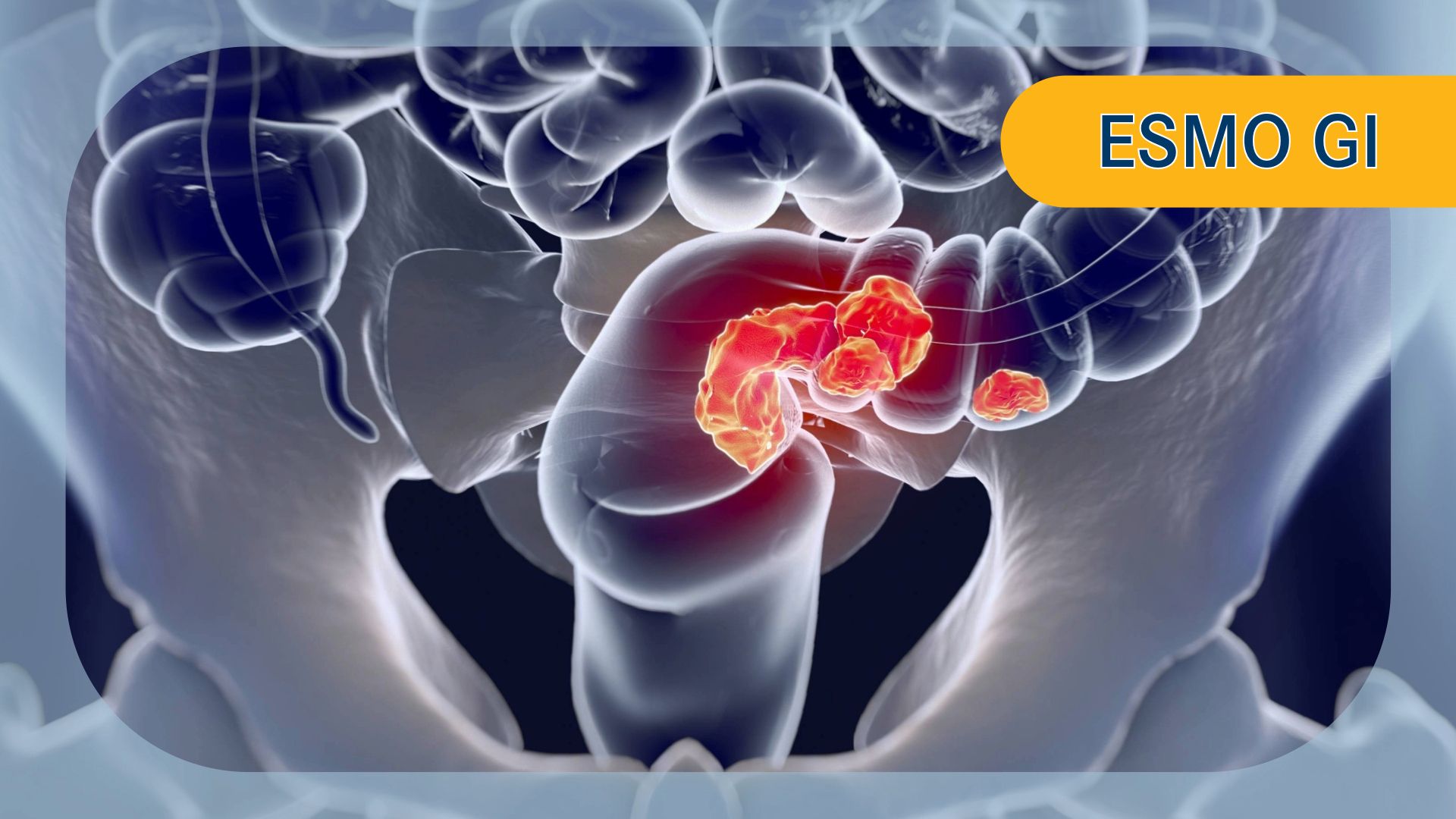
Subgroup Analysis Supports Encorafenib Plus Cetuximab/mFOLFOX6 as New SOC for BRAF V600E+ mCRC
BRAF V600E+ mCRC | Image
Credit: © Anatomy Insider
– stock.adobe.comObjective response rate (ORR), median duration of response (DOR), median progression-free survival (PFS), and median overall survival (OS) were numerically higher or extended with the combination of encorafenib (Braftovi), cetuximab (Erbitux; EC), and mFOLFOX6 (modified fluorouracil plus leucovorin and oxaliplatin), irrespective of control arm regimen, in patients with BRAF V600E–mutant metastatic colorectal cancer (mCRC), according to data from a subgroup analysis of the phase 3 BREAKWATER study (NCT04607421).1
Findings presented during the 2025 ESMO Gastrointestinal Cancer Congress showed the confirmed ORR by blinded independent central review (BICR) was 65.7% (95% CI, 59.4%-71.4%) with EC plus mFOLFOX6 (n = 236) vs 55.9% (95% CI, 43.3%-67.8%) with FOLFOXIRI (fluorouracil plus leucovorin, oxaliplatin, and irinotecan) plus bevacizumab (Avastin; n = 59), 50.0% (95% CI, 21.5%-78.5%) with FOLFOXIRI (n = 8), 38.1% (95% CI, 29.1%-48.1%) with mFOLFOX6 plus bevacizumab (n = 97), 22.2% (95% CI, 9.0%-45.2%) with mFOLFOX6 (n = 18), 29.3% (95% CI, 17.6%-44.5%) with CAPOX (capecitabine plus oxaliplatin) plus bevacizumab (n = 41), and 16.7% (95% CI, 3.0%-56.4%) with CAPOX (n = 6).
The median DORs were 13.9 months (95% CI, 10.9-18.5) with EC plus mFOLFOX6, 9.8 months (95% CI, 7.9-not evaluable [NE]) with FOLFOXIRI plus bevacizumab, 10.8 months (95% CI, 6.0-NE) with mFOLFOX6 plus bevacizumab, 9.7 months (95% CI, NE-NE) with mFOLFOX6, and 11.1 months (95% CI, 2.9-13.4) with CAPOX plus bevacizumab. In the EC plus mFOLFOX6 arm, 71.0% of patients experienced a DOR of at least 6 months, and 34.8% experienced a DOR of at least 12 months.
The median PFS with EC plus mFOLFOX6, FOLFOXIRI plus bevacizumab, mFOLFOX6 plus bevacizumab, mFOLFOX6, and CAPOX plus bevacizumab was 12.8 months (95% CI, 11.2-15.9), 10.1 months (95% CI, 8.3-13.7), 6.8 months (95% CI, 5.7-8.5), 4.3 months (95% CI, 2.7-11.0), and 5.9 months (95% CI, 4.5-9.9), respectively. The median OS in the respective groups was 30.3 months (95% CI, 2.17-NE), 17.4 months (95% CI, 14.3-23.4), 14.7 months (95% CI, 12.7-17.6), 11.6 months (95% CI, 7.5-19.6), and 14.5 months (95% CI, 11.2-22.2).
“These results are consistent with previous analyses of chemotherapy with or without bevacizumab in the first-line for the treatment of BRAF V600E mCRC,” Takayuki Yoshino, MD, PhD, of National Cancer Center Hospital East in Kashiwa, Japan, and coauthors, wrote in a poster of the data, which “[support] EC plus mFOLFOX6 as a practice-changing, new standard of care for BRAF V600E–mutant mCRC, including the first-line setting.”
Breaking Down BREAKWATER
The open-label, multicenter, phase 3 study enrolled patients with BRAF V600E–mutant mCRC who were at least 16 years of age—or at least 18 years of age based on country—with measurable disease by RECIST 1.1 criteria, an ECOG performance status of 0 or 1, and acceptable bone marrow, hepatic, and renal function. Patients could not have previously received systemic treatment for metastatic disease. Those with prior exposure to BRAF or EGFR inhibitors, symptomatic brain metastases, microsatellite instability–high/mismatch repair–deficient tumors, or RAS-mutated disease were excluded.
Patients (n = 637) were randomly assigned 1:1:1 to EC (n = 158), EC plus mFOLFOX6 (n = 236), or the control arm (n = 243) of mFOLFOX6/FOLFOXIRI/CAPOX with or without bevacizumab. Notably, the trial protocol was subsequently amended to limit randomization to the EC plus mFOLFOX6 arm and the control arm.2
Patients were stratified by region (US or Canada vs Europe vs rest of world) and ECOG performance status (0 vs 1).1 The dual primary end points were PFS by BICR and ORR by BICR, and a key secondary end point was OS.
Both of the primary end points were met. The ORR—based on the first 110 patients enrolled to both groups—was 61% (95% CI, 52%-70%) in patients given EC plus mFOLFOX6 compared with 40% (95% CI, 31%-49%) for patients treated with chemotherapy with or without bevacizumab (Avastin; P = .0008).2 The data supported the FDA’s decision to grant accelerated approval to EC plus mFOLFOX6 for use in patients with mCRC harboring a BRAF V600E mutation, as detected by an FDA-approved test, in December 2024. The median PFS with EC plus mFOLFOX6 was 12.8 months vs 7.1 months with standard care (HR, 0.53; 95% CI, 0.41-0.68; P < .001).3 In an interim analysis, OS was significantly longer with EC and mFOLFOX6 vs standard care, at a median of 30.3 months vs 15.1 months (HR, 0.49; 95% CI, 0.38-0.63; P < .001).
Examining the Current Subgroup Analysis
Of the total patients randomly assigned to the control arm (n = 243), 24.3% received FOLFOXIRI plus bevacizumab, 3.3% received FOLFOXIRI, 39.9% received mFOLFOX6 plus bevacizumab, 7.4% received mFOLFOX6, 16.9% received CAPOX plus bevacizumab, 2.5% received CAPOX, and 5.8% were not treated.
“Patients who received FOLFOXIRI plus bevacizumab were younger, and more patients were male, had ECOG performance status of 0, had 3 or more organs involved at baseline, and had left-sided tumors vs patients in the EC plus mFOLFOX6 and patients who received the other control regimens,” the study authors wrote.
The median follow-up for PFS in the EC plus mFOLFOX6 arm was 16.8 months (95% CI, 15.1-18.4) vs 9.8 months (95% CI, 8.5-13.0) in the control arm. The median follow-up for PFS in the respective arms was 21.8 months (95% CI, 20.4-23.4) and 22.2 months (95% CI, 18.9-23.5).
“The EC plus mFOLFOX6 arm had fewer patients discontinue study treatment compared with all control regimens,” the study authors wrote. The percentages of patients who discontinued study treatment in the EC plus mFOLFOX6, FOLFOXIRI plus bevacizumab, FOLFOXIRI, mFOLFOX6 plus bevacizumab, mFOLFOX6, CAPOX plus bevacizumab, and CAPOX were 71.6%, 86.4%, 87.5%, 94.8%, 100%, 95.1%, and 100%, respectively; the respective percentages of patients who received any subsequent systemic anticancer treatment were 45.8%, 59.3%, 75.0%, 58.8%, 55.6%, 63.4%, and 50.0%.
In the EC plus mFOLFOX6 arm, subsequent therapies included a BRAF inhibitor with or without combination (8.1%), CAPIRI with or without combination (4.7%), CAPOX with or without combination (0.8%), FOLFIRI with or without combination (24.2%), FOLFOX with or without combination (4.2%), FOLFOXIRI with or without combination (1.3%), fruquintinib (Fruzaqla; 0.4%), immunotherapy (0.4%), other (3.4%), regorafenib (Stivarga; 1.3%), single-agent chemotherapy with or without combination (7.2%), and trifluridine/tipiracil (Lonsurf) with or without VEGF inhibition (4.2%).
“Safety profiles were consistent with that known for each agent,” the study authors concluded.
Disclosures: Yoshino reported honoraria from Bayer Yakuhin, Chugai Pharma, Merck KGaA, MSD, Ono Pharmaceutical, Sumitomo Corp, and Takeda. Research funding was provided by Amgen, Boehringer Ingelheim, Chugai Pharma, Daiichi Sankyo Co Ltd, Eisai, FALCO Biosystems, Genomedia, Molecular Health, MSD, Nippin Boehringer Ingelheim, Ono Pharmaceutical, Pfizer, Roche Diagnostics, Sanofi, Sumitomo Dainippon, Sysmex, and Taiho Pharmaceutical.
References
- Yoshino T, Kopetz S, Van Cutsem E, et al. BREAKWATER: Post-hoc subgroup analyses by chemotherapy ± bevacizumab regimens vs encorafenib plus cetuximab + mFOLFOX6. Presented at: 2025 ESMO Gastrointestinal Cancers Congress; July 2-5, 2025; Barcelona, Spain. Abstract 36P.
- FDA grants accelerated approval to encorafenib with cetuximab and mFOLFOX6 for metastatic colorectal cancer with a BRAF V600E mutation. FDA. December 20, 2024. Accessed July 4, 2025. https://www.fda.gov/drugs/resources-information-approved-drugs/fda-grants-accelerated-approval-encorafenib-cetuximab-and-mfolfox6-metastatic-colorectal-cancer-braf
- Elez E, Yoshino T, Shen L, et al. Encorafenib, cetuximab, and mFOLFOX6 in BRAF-mutated colorectal cancer. N Engl J Med. 2025;392(24):2425-2437. doi:10.1056/NEJMoa2501912
Continue Reading
-
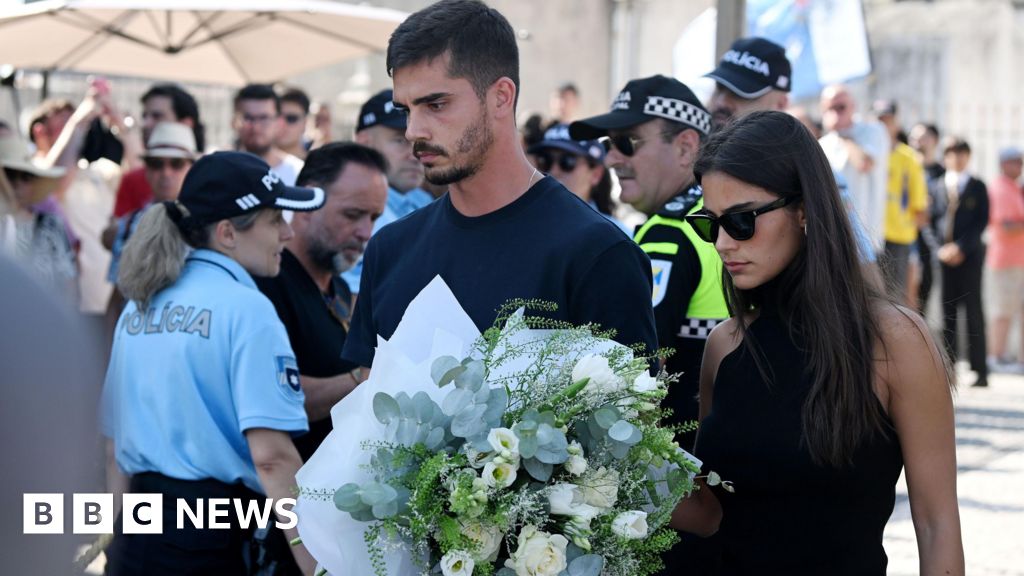
Crowds mourn Liverpool star Jota in his Portuguese hometown
James WaterhouseBBC News
Reporting fromGondamar, Portugal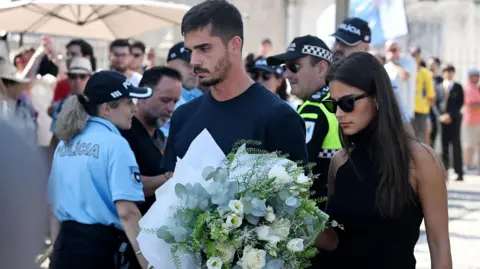 PA Media
PA MediaPortugese national team player Andre Silva was among footballers and politicians to attend the public wake in Gondomar Crowds mourned Diogo Jota in his hometown to pay their respects to the Liverpool forward and his brother Andre Silva, who both died in a car crash on Thursday.
Portugal’s president, stars from the national team and fans from across the country gathered in the small town of Gondomar, on the outskirts of Porto, where the pair grew up.
Their parents, grandfather and other family members held a private vigil at a chapel in the town before it was opened to the public for a wake. The funeral will be held on Saturday.
The pair – both footballers, with Andre playing in Portugal’s second division – were killed after the Lamborghini they were travelling in crashed in the Spanish province of Zamora.
Fans carrying Portugal flags, flowers and other memorabilia were seen weeping as they queued to pay their respects.
Those in attendance included President Marcelo Rebelo de Sousa, Prime Minister Luis Montenegro, national team stars Joao Moutinho, Diogo Dalot and Ricardo Horta, and Jota’s agent Jorge Mendes.
For years as a young boy, Jota played for local club Gondomar SC, which named its academy after him in 2022.
Emblazoned on its sign is a quote from Jota: “It’s not about where we come from but where we’re going to.”
Outside the club, shirts and scarves were laid inside a ring of candles.
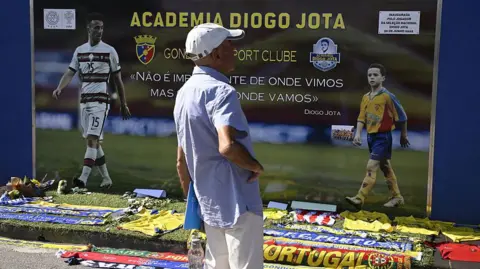 Getty Images
Getty ImagesThe 28-year-old father-of-three – who this year won the Nations League with Portugal and Premier League with Liverpool – married his long-term partner Rute Cardoso just 11 days before the fatal crash.
He had been travelling back to Liverpool for pre-season training, making the trip by car and ferry because he had undergone minor surgery and had been advised against flying.
Liverpool said his death was a “tragedy that transcends” the club.
Fans also grieved outside the club’s Anfield stadium.
Former captain Jordan Henderson was seen in tears as he laid a wreath, with a card that read: “Rest in peace my friend, along with your brother Andre. We will all miss you.”
Former Liverpool councillor Peter Millea – a home and away regular who had come to pay his respects – told the BBC: “There was something about him as a player when he first came to us that he became an instant hit.
 PA Media
PA Media“He was one of those players you can easily take to, because of the manner in which he conducted himself on and off the pitch and the important goals he scored.”
Mr Millea said some fans at Anfield had broken into impromptu renditions of the chant while paying their respects.
“I’m sure we’ll hear it loud and clear at Wembley for the Community Shield and we’ll hear it at Preston for the first pre-season away game, you know it’ll be sung around the field against Athletic Bilbao and then during the course of the rest of the season and probably forever-more,” he said.
Elsewhere, fans left flowers, scarves and shirts outside Wolves’ Molineux Stadium, where Jota played prior to his move to Anfield.
At Wimbledon, Portuguese tennis player Francisco Cabral wore a black ribbon to mark the passing of his countrymen.
A minute’s silence was held in the Euro 2025 game between Denmark and Sweden.
Liverpool has cancelled pre-season fitness tests that were due to take place today for some players as a result of yesterday’s news. A phased return of training will now begin on Monday.
The funeral service will be held at the Igreja Matriz de Gondomar in Sao Cosme in Gondomar at 10:00 on Saturday.
Continue Reading
-
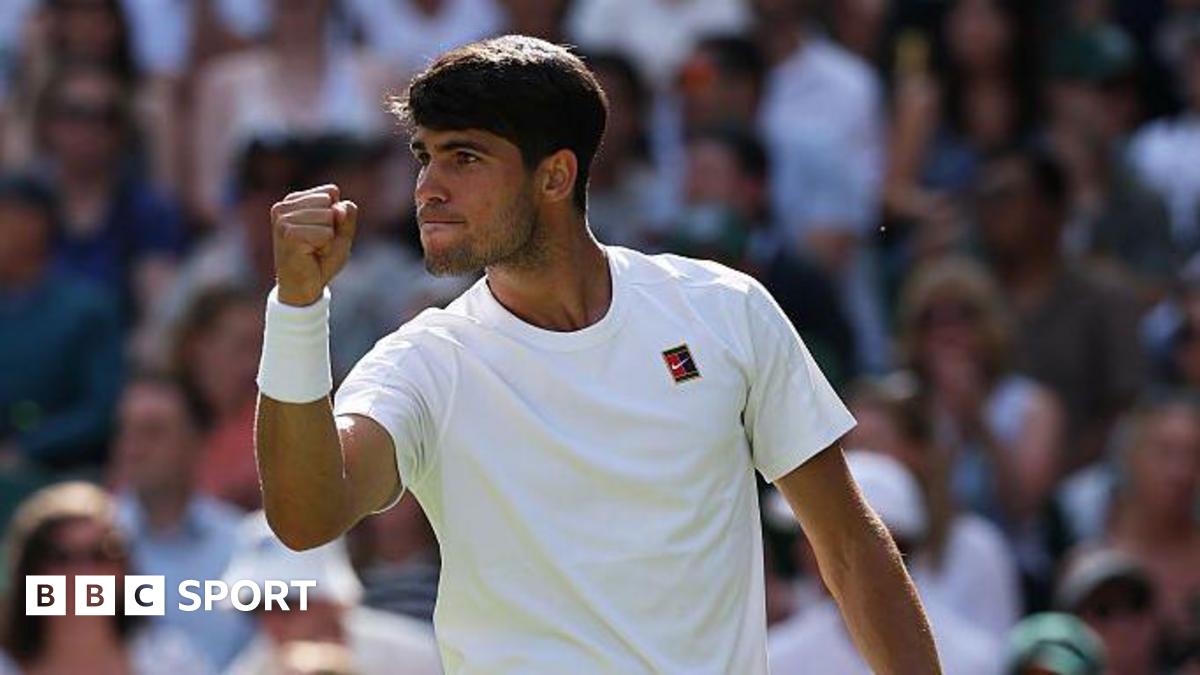
Wimbledon 2025 results: Carlos Alcaraz beats Jan-Lennard Struff to reach round four
Defending champion Carlos Alcaraz kept himself on course for a third Wimbledon title in a row by overcoming Jan-Lennard Struff in an enthralling encounter to reach the fourth round.
The world number two has yet to really hit his stride at the tournament but came through some big pressure situations and produced moments of quality in this match to seal a 6-1 3-6 6-3 6-4 win.
Alcaraz will next face 14th seed Andrey Rublev – who beat Adrian Mannarino 7-5 6-2 6-3 – for a place in the quarter-finals.
“I knew it was going to be difficult,” the 22-year-old Spaniard said.
“He has big serves, approaches the net and I am really pleased with everything I had done today.
“I am proud to get the win in four sets. It was stressful as well. I was suffering in every set that I did today.”
Alcaraz had to battle through five sets and almost five hours on court to see off Fabio Fognini in the opening round and, although he did then beat British wildcard Ollie Tarvet in straight sets, he had to fend off a number of chances the Wimbledon debutant had to break him.
Initially, it looked like he would sail past world number 125 Struff in front of an expectant Centre Court crowd on Friday as he wrapped up the opening set in under 30 minutes, dropping just one game to the German.
But the second set was a different story as Struff found his power and accuracy on his serve. Having not managed a single ace in the first set, he hit four in the second to help him break Alcaraz twice and level up matters.
But that accuracy deserted the German number three early in the third. Three double faults gifted Alcaraz a break to go 2-0 up and he stayed in control to take the set.
The pressure ramped up in the fourth but Alcaraz showed the quality that has allowed him to go 21 matches unbeaten.
He fended off a couple of potential break opportunities before a wonderful backhand volley at the net helped him on the way to a crucial break at 4-4.
That had the Centre Court crowd up on their feet before Alcaraz wrapped up the set and the match with a dominant hold to love to cement his place in the next round.
Continue Reading
-
Alcaraz survives Struff test – Wimbledon
- Alcaraz survives Struff test Wimbledon
- Alcaraz drops a set in Struff Wimbledon R3 win ATP Tour
- Carlos Alcaraz comes through ‘stressful’ Jan-Lennard Struff test Ardrossan Herald
- Wimbledon: Defending champion Carlos Alcaraz extends winning streak to reach 4th round Ottumwa Courier
- Alcaraz vs Struff: What time is it and where to watch Wimbledon 2023 on TV? MARCA
Continue Reading
-

First report of Aedes albopictus in Saint Barthélemy (French West Indies) confirmed by morphological, molecular and MALDI-TOF mass spectrometry approaches | Parasites & Vectors
The French Territories of the Americas are regions frequently impacted by arthropod-borne viruses transmitted by Aedes aegypti mosquitoes, such as dengue, chikungunya, and Zika viruses [1]. However, the presence of Aedes albopictus, another important mosquito vector for arboviruses [2], had never been reported in any of these territories, despite the impressive spread of this mosquito in mainland France since 2004 [3]. In the Caribbean, Ae. albopictus was first reported in the Dominican Republic in 1993 [4].
On 30 September 2024, two vector control agents collected mosquito larvae from a floor siphon (17°54′20″N, 62°49′28″W) near the Lorient post office on the island of Saint Barthélemy, as part of their routine entomological surveillance activities that include weekly larval prospections and ovitrapping. The larvae were brought to the Vector Control Agency office (Agence Régionale de Santé [ARS]) in Saint Barthélemy and reared until adulthood. After emergence, the agents noted the presence of adult mosquitoes that did not match morphological criteria for Ae. aegypti and photographed the mosquitoes. Entomologists from ARS Guadeloupe, ARS Martinique and from local research institutions examined the photographs and confirmed the agents’ suspicion that the mosquitoes were Ae. albopictus.
Two weeks later, an exploration mission was organized, during which agents from ARS Guadeloupe, ARS Saint Barthélémy, and the Institut Pasteur of Guadeloupe (IPG) traveled to Saint Barthélémy to confirm the species’ identity and to inform about its distribution area on the island. Larval prospections conducted from 14 to 16 October identified five breeding sites within a 400-m radius of the initial detection site, all containing mosquitoes morphologically identified as Ae. albopictus (Table 1).
Table 1 Aedes albopictus breeding sites identified in Saint Barthélemy (French West Indies) between 14 and 16 October 2024 Morphological criteria described by Darsie [5] were initially used during the missions to identify Ae. albopictus at both the larval and adult stages (Fig. 1a–c). However, since Ae. albopictus shares morphological similarities with other members of the Scutellaris group, further identification steps were performed on two collected specimens using matrix-assisted laser desorption ionization—time-of-flight mass spectrometry (MALDI-TOF MS) and cytochrome c oxidase 1 (cox1) gene barcoding to confirm the species. Briefly, the two specimens were individually dissected to separate the head and thorax from the rest of the body, and then homogenized 3 × 1 min at 30 Hz in a tissue lyzer (Retsch GmbH, Haan Germany). Legs and/or thoraxes were separately treated for identification by MALDI-TOF MS as previously described [6]. Protein mass profiles were acquired using a Maldi Biotyper Sirius Mass Spectrometer (Bruker Daltonics, Bremen, Germany), operating in linear positive-ion mode, with detection at a laser frequency of 50 Hz within a mass range of 2–20 kDa. MALDI-TOF spectra databases shared between entomologists from the Institut Pasteur of New Caledonia and the IHU Méditerranée enabled almost instantaneously confirmation of the samples as Ae. albopictus species, with the relevant score for the two specimens (log-score identification value = 2.05, matching spectra of Ae. albopictus from Cameroon [using mosquito legs from specimen 1] and from Marseille [using mosquito thorax from specimen 2]). To evaluate spectral similarity between specimen 1, which was collected in Saint-Barthélemy, and those from other Ae. albopictus, we generated a clustering analysis via the MSP (main spectra library) dendrogram function in MALDI-Biotyper v3.0 software. (Bruker Daltonics) using MS spectra from Ae. albopictus and five other Aedes species from the Scutellaris group (Aedes scutellaris, Aedes pseudoscutellaris, Aedes futunae, Aedes malayensis and Aedes polynesiensis). The resulting MSP dendrogram showed that the spectrum of the Saint-Barthélemy specimen clustered together with those of other Ae. albopictus, ruling out the possibility of other species from the Scutellaris group (Fig. 1d). These results highlighted the high reproducibility and the specificity of protein profiles among Aedes species, allowing a rapid and relevant identification of the specimen.
Fig. 1 Identification of adult Aedes albopictus specimens found in Saint Barthélémy (French West Indies) according to morphological criteria (A, B, C), MALDI-TOF MS analysis (D) and cox1 gene barcoding (E). A Abdomen view: abdominal terga with complete basal white bands (red arrow), B thorax view: scutum with a medial-longitudinal white stripe (red arrow), C thorax view: mesepimeron with non-separated white scales, forming a V-shaped white spot (red arrow). D Main spectrum profile (MSP) dendrogram of Aedes Scutellaris Group. Spectrum from the mosquito specimen collected in Saint Barthélémy was obtained with a Maldi Biotyper Sirius mass spectrometer (Bruker Daltonics), and the dendrogram was generated by MALDI Biotyper Compas Explorer software. Distance units correspond to the relative similarity between spectra of Ae. albopictus from Saint Barthélémy and those from IHU Méditérranée and Institut Pasteur New Caledonia databases. E Molecular phylogenetic tree generated by the maximum likelihood method. The percentage bootstrap values shown at the nodes were calculated with 1000 replicates, and only bootstrap values > 70 are shown. Scale bar indicates nucleotide substitutions per site. Aedes albopictus sequences or spectra from Saint Barthelemy specimens are indicated in red and bold. cox1, Cytochrome c oxidase 1 gene; IHU, Institut hospitalo-universitaire; MALDI-TOF MS, matrix-assisted laser desorption ionization—time-of-flight mass spectrometry. Mosquito pictures were taken by Fabrice Sonor
We subsequently used the remaining body parts from the two specimens to conduct cox1 barcoding. Total DNA was extracted using the cetyltrimethylammonium bromide technique as previously described [7] and sequenced by Eurofins Genomics Europe (Sanger sequencing) using the primers HCO2198 and LCO1490 [6]. Sequences were analyzed, and multiple sequence alignment (Clustal W) was conducted using BioEdit version 7.0.5.3 software (BioEdit, Manchester, UK) [8, 9]. A molecular phylogenetic tree was generated by the maximum likelihood method based on the Timura 3-parameter model (best-fit nucleotide substitution pattern determined according to the corrected Akaike Information Criterion) using MEGA (http://www.megasoftware.net) with a bootstrap of 1000 replications [10]. Barcoding results indicated that the sequences from the mosquitoes collected in Saint Barthélemy (GenBank accession no. PQ644904 and PQ644905) shared 100% homology with sequences from Ae. albopictus collected in Europe and the Americas (Fig. 1e).
In the following weeks, weekly entomological surveillance continued, and the number of Ae. albopictus-positive breeding sites on Lorient increased to 18 in a 665-m2 area. The species’ presence was also detected in five breeding sites within a 150-m2 area in Saint Jean (17°53′50″N, 62°50′14″W). The discovery of this second hotspot, located 1.6 km from Lorient and near the airport, suggests a broader distribution of the species on the island. The presence of this invasive mosquito species in Saint Barthélémy, an island with daily aerial or maritime connections to the French Departments of the Americas [11], raises concerns about the risk of its introduction into these territories, as well as into other Caribbean countries. After the first detection of Ae. albopictus in the Dominican Republic in 1993 [4], the species has been reported in an increasing number of Caribbean territories, including Cuba in 1995 [12], Cayman Islands in 1997 [13, 14], Trinidad in 2002 [15], Haiti in 2010 [16], and Jamaica in 2018 [17] (Fig. 2).
Fig. 2 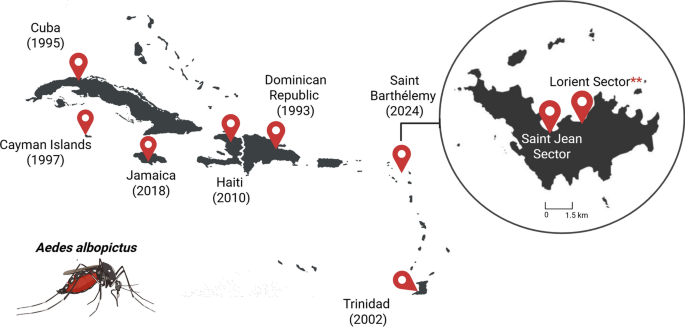
Aedes albopictus distribution in the Caribbean. Countries or territories reporting the species have been marked with red location pins. Date of first detection is given in parentheses. Asterisks indicate the first detection in Saint Barthélemy. cox1, Cytochrome c oxidase 1 gene; IHU, Institut hospitalo-universitaire; MALDI-TOF MS, matrix-assisted laser desorption ionization—time-of-flight mass spectrometry. Created with BioRender.com
It is noteworthy that in Cuba, from 1995 to 1999, Ae. albopictus was mainly distributed in peripheral municipalities with abundant vegetation rather that in more urbanized areas (i.e. city center). However, an increase in the species’ distribution in more urbanized areas, in association with Ae. aegypti, was observed from 2010 to 2018, highlighting the competitiveness of Ae. albopictus in the Caribbean context and an invasion process that can take several years [18]. In Saint Barthélemy, a 25-km2 island, Ae. albopictus is already present in artificial breeding sites from urban settings. In addition, half of these breeding sites contained the species in association with Ae. aegypti individuals (Table 1). In this context, the ecological plasticity of Ae. albopictus [19, 20] will likely facilitate its rapid invasion of Saint Barthélémy, emphasizing the urgent need to locally reinforce vector surveillance and control measures to prevent the further spread of this mosquito.
This work also highlights the efficiency of MALDI-TOF MS for rapidly identifying mosquito specimens in a real-life surveillance situation. The value of this approach for entomological surveillance has been repeatedly shown [21, 22]. Although MALDI-TOF MS-based identification requires reference spectra databases to identify specimens, as well as standardized protocols for spectrum acquisition [23], the exchange of databases between regions and institutes with access to different mosquito species represents a key development perspective. This is particularly relevant in our increasingly globalized world, where the potential for transcontinental movements of viruses and vectors continues to grow.
Continue Reading
-
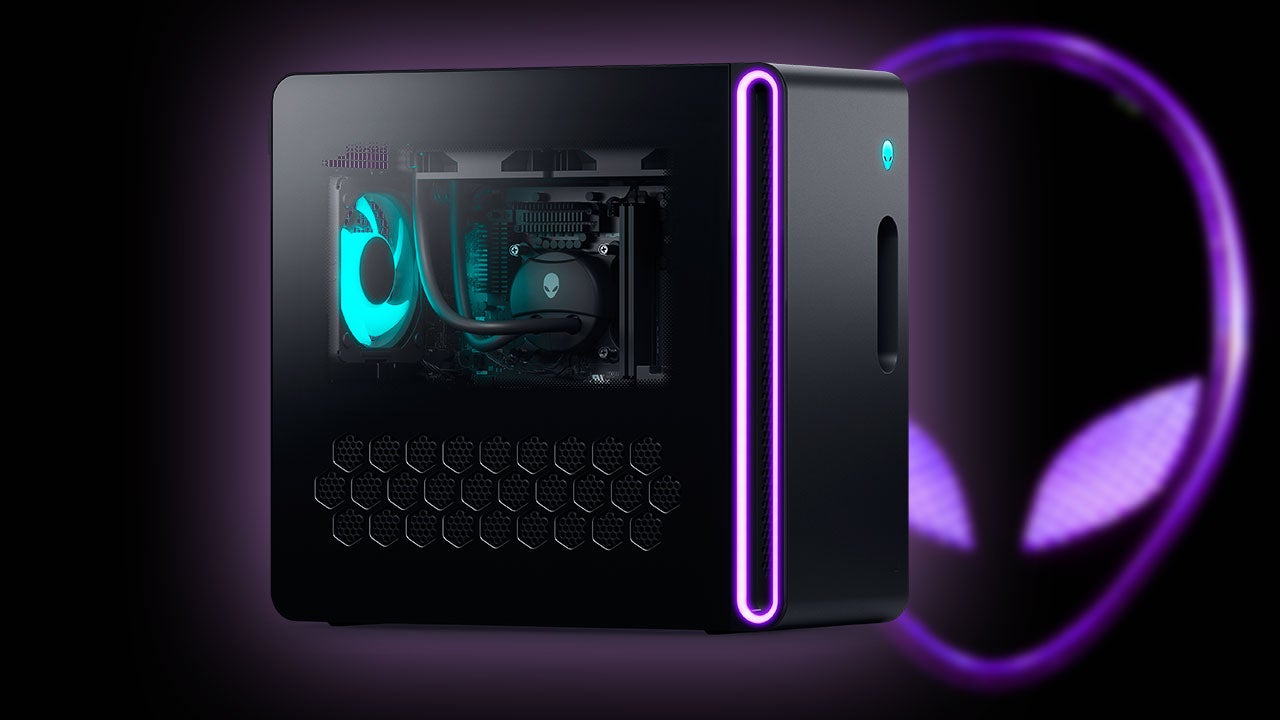
The Alienware Aurora R16 RTX 5080 Gaming PC Drops to Under $2K for the First Time for 4th of July
Alienware’s Black Friday in July Sale has officially kicked off, and one of the best deals I’ve seen so far is this Alienware Aurora R16 RTX 5080 gaming PC for just
$2,099.99$1,999.99 shipped. This is $350 less than the previous best deal I’ve seen on the same configuration, and one of the best prices you can get for any prebuilt RTX 5080 gaming PC. The Alienware Aurora R16 is a well-engineered and compact gaming rig with 240mm AIO water cooling, sensible airflow design, and a generous 1,000W 80Plus Platinum rated power supply. In the current market, buying a prebuilt gaming PC is the only way to score an RTX 5080 GPU without paying an exorbitant markup. If you were to try to find a 5080 GPU for your do-it-yourself PC build, you’ll probably spend $1,400 for the graphics card alone.Update: Price has dropped yet again from $2,099.99 to $1,999.99. This is the first time I’ve seen an Alienware RTX 5080 gaming PC priced under $2K, so get it while you can.
Alienware Aurora RTX 5080 Gaming PC From $1,999.99
Hot Black Friday in July Deal
Alienware Aurora R16 Intel Core Ultra 7 265F RTX 5080 Gaming PC (16GB/1TB)
37
This system is equipped with an Intel Core Ultra 7 265F processor, GeForce RTX 5080 graphics card, 16GB of DDR5-5600MHz RAM, and a 1TB M.2 SSD. Note that this is a customizable configuration so you can upgrade the CPU and GPU or increase your memory or storage capacity. It’s pre-configured with a 240mm all-in-one liquid cooling solution.
The Core Ultra 7 265F is part of Intel’s newest Arrow Lake-S lineup released earlier this year and boasts a max turbo frequency of 5.3GHz with 20 cores and a 36MB L2 cache. This is an excellent all-around CPU for gaming, multi-tasking, and general workstation performance. For gaming, you won’t see any improvement upgrading to a Core Ultra 9.
The GeForce RTX 5080 GPU will run any game in 4K
The RTX 5080 is the second best Blackwell graphics card, surpassed only by the $2,000 RTX 5090. It’s about 5%-10% faster than the previous generation RTX 4080 Super, which is discontinued and no longer available. In games that support the new DLSS 4 with multi-frame generation exclusive to Blackwell cards, the gap widens. This is an outstanding card for playing even the latest games at 4K resolution with high settings and ray tracing enabled.
Check out more Alienware Black Friday in July deals
Check out our Best Alienware Deals article with all of Dell’s currently ongoing deals on gaming laptops and desktop PCs. Not everyone is the DIY type. If you’re in the market for a prebuilt gaming PC, Dell is one of the best brands we’d recommend. Alienware desktops and laptops feature solid build quality, top-of-the-line gaming performance, excellent cooling (further improved on the newer models), aggressive styling, and pricing that is very competitive with other pre-built options. Best of all, there are plenty of sales that happen throughout the year, so it’s not difficult to grab one of these computers at considerably less than their retail price.
Eric Song is the IGN commerce manager in charge of finding the best gaming and tech deals every day. When Eric isn’t hunting for deals for other people at work, he’s hunting for deals for himself during his free time.
Continue Reading
-

Where are they headed for honeymoon?
Jeff Bezos and Lauren Sanchez know how to leave a mark with everything they do.
The couple made headlines with a lavish $50 million wedding in Venice, Italy attended by a long list of celebrities and media personalities including Leonardo Dicaprio, Orlando Bloom, Sydney Sweeney, Kim Kardashian, Oprah Winfrey, Tom Brady and many more.
Now the newly-wed couple is off to spend their honeymoon at a location that has immense value for the TV fans.
As reported by Independent, the pair is at San Domenico Palace, a Four Seasons hotel in Taormina, Sicily.
The venue is internationally recognized for its role as the ‘setting’ for HBO series The White Lotus season two.
The 61-year-old and the 55-year-old reached the Nicelli airport from Venice to take a helicopter ride back to the Amazon founder’s $500 million superyacht Koru.
The yacht is currently anchored in Taormina while the two are enjoying some quality time together.
For the unversed, while the wedding has drawn backlash from some people including Charlize Theron and Rosie O’Donnell, the bride had prepared hard for the wedding.
The licensed pilot had brought some lifestyle changes including dietary to lose a few pounds before walking down the aisle.
Additionally, she also got a piercing on the nail of her ring finger to take her glam look up a notch.
The nail artist Iram Shelton pierced a diamond-encrusted ‘B’ charm into the long nail.
Continue Reading
-
125,000-year-old ‘fat factory’ run by Neanderthals discovered in Germany – MSN
- 125,000-year-old ‘fat factory’ run by Neanderthals discovered in Germany MSN
- Neanderthals had a ‘fat factory’ where they processed bones for grease New Scientist
- The clever ways Neanderthals got their fat long before modern humans News-Medical
- Neanderthals had a “fat factory” for processing bone grease 125,000 years ago – much earlier than thought Popular Archeology
- Neanderthals Ran “Fat Factories” 125,000 Years Ago Universiteit Leiden
Continue Reading
-
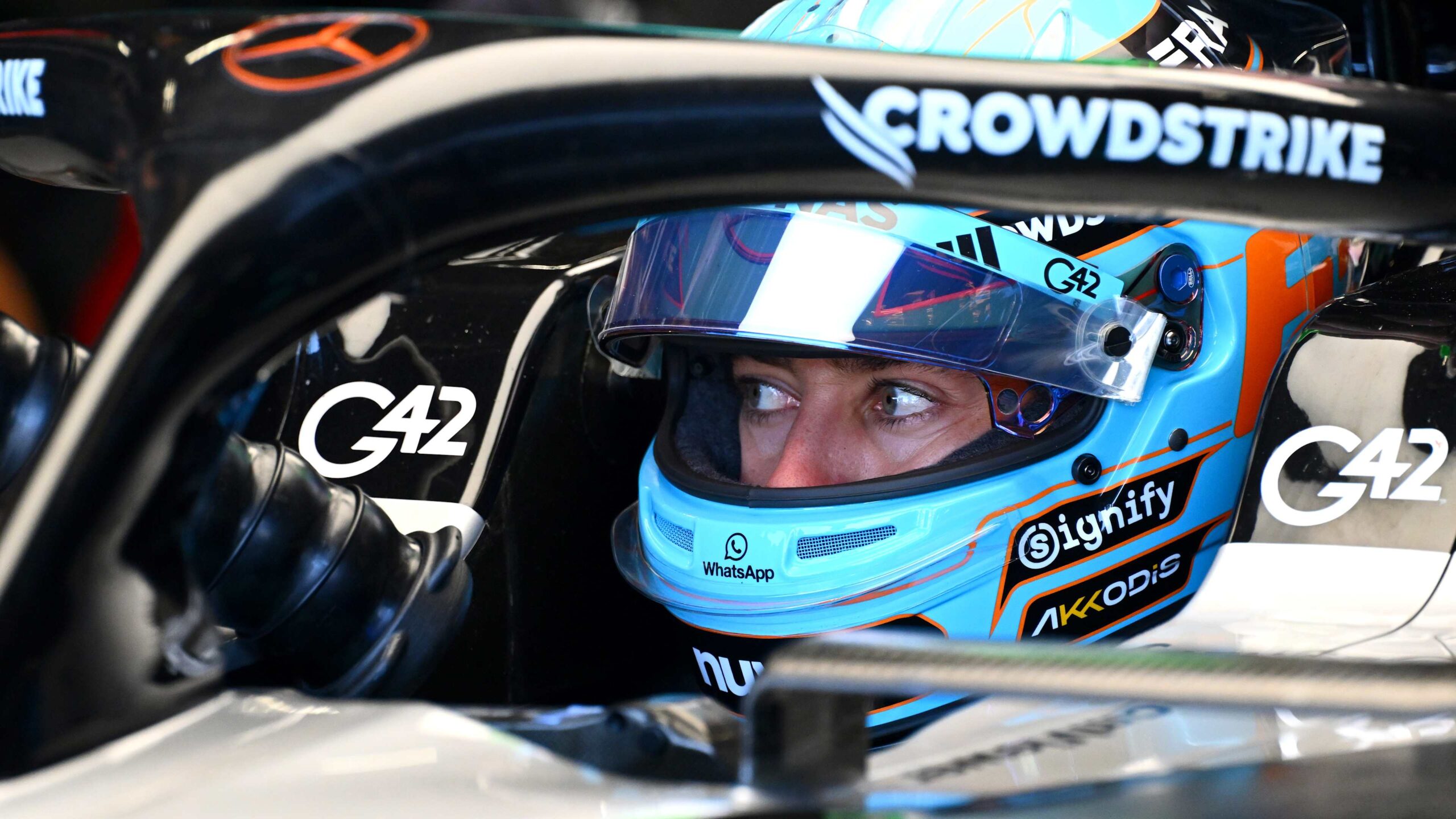
George Russell admits Mercedes ‘not close’ to frontrunners on Friday at Silverstone as he hopes for cooler weather
George Russell conceded that Mercedes were “not close” to the frontrunners during the opening day of action at Silverstone, with the Briton admitting that the squad are hoping for the temperatures to drop during the remainder of the weekend.
After ending Free Practice 1 in fifth place on the timesheets, Russell classified eighth in the second session on a lap seven-tenths off the pace-setting time of McLaren’s Lando Norris.
When asked how close he felt to those at the front following Friday’s running, the 27-year-old answered: “Well after today not very close, but it has been warmer today. The track was 40 degrees and we are hoping the rest of the weekend it cools down.
“So it is a little frustrating for us that every single week we are at the mercy of the weather and we need to improve that, especially now we are entering the summer months. We are doing everything we can to improve it.
“I think our fortunes will turn a little bit and it will come back towards us but, as I said, we can’t be at the mercy of the weather and we are right now.”
With Ferrari proving to be McLaren’s closest competitors during Friday, Russell suggested that the Scuderia have taken a step forward.
“Ferrari have really turned it up the last couple of races,” the 27-year-old explained. “They’ve been strong in race pace all season really, but they’ve been having bad Qualifyings.
“But I think now we are entering summer, everyone is overheating a little bit more and we are probably taking a step backwards, and they’ve taken a step forward purely because of the temperature.
“So that’s probably not great for them for some reasons, but it is also not great for us for other reasons too. Anyway, I’m enjoying being here at Silverstone, enjoying seeing all the fans. I love this race weekend and I just hope we can improve for the rest of the week.”
Despite having a tricky Friday, Russell responded positively when asked if the arrival of rain or gustier conditions could put Mercedes back in the fight for pole position on Saturday.
“Yeah for sure, coldness definitely. If it is wet for Qualifying then definitely excited for that,” the four-time race winner said. “It’s a bit of a unique one because the wet tyres actually deg more than the dry tyres.
“It’s like, I don’t want to get too bogged up in the details here but actually a wet race probably wouldn’t be ideal. But we just want it… cold and dry would be ideal.”
Kimi Antonelli echoed his team mate’s sentiments about the difficulties of Friday, the Italian having placed P9 and P6 in first and second practice respectively.
“[It] was definitely not the easiest today, but I’m having quite a lot of pleasure driving around here,” Antonelli reflected. “Today, temperatures were quite a bit higher than expected.
“Overall to be honest the car didn’t feel too bad, there is a little bit to work on and a little bit to work on with the driving. But tomorrow hopefully it is going to be a lot cooler, that is what the forecast is saying, and we’ll see what we can do.”
Like Russell, Antonelli is hopeful that Mercedes can be in the battle with Ferrari and McLaren if the temperatures cool as the British Grand Prix event progresses.
“Hopefully, that is definitely the goal,” the 18-year-old added. “I think hopefully it is going to cool down. Tomorrow is predicted to be overcast so probably track temp will be a bit cooler. I don’t know by how much, but a little bit cooler and hopefully we can take the fight to Ferrari and the McLarens.”
Continue Reading
